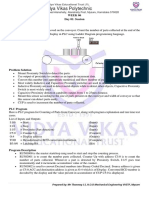QueuingTheory Matlab Assignment
Uploaded by
Shyam ShankarQueuingTheory Matlab Assignment
Uploaded by
Shyam ShankarMini Project: Queuing Theory Matlab Assignment
Group Roll No of
No. Students Name of Students
1 EE15B016 B.VISWA CHAITANYA
EE15B021 CH.PHANI VIGNAN
2 EE15B014 B. AGNI RAJ
EE15B028 G. S. ASWATH
3 EE15B070 A.MANISH REDDY
EE15B112 SARATH B
4 EE14B101 RAJAT RAO
EE14B106 SAMEER KULKARNI
5 EE15B131 KEERTHI SURESH
EE15B074 ANIT TOMY
6 EE15B008 A.Tarun
EE15B024 G.V.K.Chaitanya
7 EE15B003 Abhiman N
EE15B127 Shyam Shankar
8 EE16D415 Amritha R
EE17D056 Navya
9 ME17D018 Sudeepta Ranjan Sahoo
EE16S038 Bhaswar Majumder
10 EE14B028 Kevin Selva Prasanna V
CS17D012 Chigullapally Sriharsha
11 EE15B056 Samyak Raj Pasala
EE14B128 Abhijith S Gupta
12 EE17M002 Pranav Opal
EE17M003 Neeraj
Group 1: M/M/S/B (An M/M/S queue with S servers that limit the number
of customers to 'B’ after which customers are lost) .Analyze the queue for 3
values of server utilization factor, 0.2, 0.5 and 0.8. (S=10, B=50)
Group 2: A system of two servers where customers from outside the
system arrive at server 1 at a Poisson rate 4 and at server 2 at a Poisson rate
5. The service rates of 1 and 2 are respectively 8 and 10. A customer upon
completion of service at server 1 is equally likely to go to server 2 or to
leave the system , whereas a departure from server 2 will go 25 percent of
the time to server 1 and will depart the system otherwise.
Group 3: A two-class non-pre emptive resume priority M/M/1 queuing
system with λ 1 = 1 and λ 2 = 2, X 1 and X 2 are exponentially distributed.
Group 4: M/M/1 queue with impatient customers where each customer
will only spend an exponential time with rate α in queue before quitting the
queue.
Group 5: M/G/1 queue with server vacation such that vacation time, V and
service time, X are exponentially disributed and E[V]=10E[X].
Group 6: M/M/1 queue where each customer join the queue with
probability (0.7)n where n is the present number of customer in the queue.
(state dependent arrival)
Group 7:Generate a traffic based on Pareto distribution and send it to a
server with a deterministic service time and analyze the system (Number of
customers in the system, average time delay through the system, Number of
customers in the queue, etc. ) as the parameters of the Pareto distribution are
changed?
Group 8: Generate a Markov Modulated Poisson Process and send it to a
server with a deterministic service time and analyze the system (Number of
customers in the system, average time delay through the system, Number of
customers in the queue, etc. )?
Group 9: Simulate two M/M/1 Queues in tandem and analyze the
system(find N1(Number of Customers in the first queue),N2(for the second
queue),T1,T2, etc)?
Group 10:For an M/M/m system with server loss, using Erlang-B formula
,calculate the blocking probability and compare them with the simulation
results?
Group 11: A two-class pre-emptive resume priority M/M/1 queuing system
with λ1 = 1 and λ 2 = 2, X 1 and X 2 are exponentially distributed.
Group 12: To simulate an M/M/1/K queue with state dependent service rate
(µ_n = (1.1^n) µ)
You might also like
- IEEE-754 Floating Point Multipler in Verilog55% (11)IEEE-754 Floating Point Multipler in Verilog8 pages
- Differential Equations One Shot #BounceBack100% (2)Differential Equations One Shot #BounceBack131 pages
- Executive Engineers As On 18th January 2014No ratings yetExecutive Engineers As On 18th January 201419 pages
- Automation and Robotics Week 06 Theory Notes 20ME51INo ratings yetAutomation and Robotics Week 06 Theory Notes 20ME51I9 pages
- Applied Mathematics-I Applied Mathematics-II: Ane Books Pvt. LTDNo ratings yetApplied Mathematics-I Applied Mathematics-II: Ane Books Pvt. LTD6 pages
- Gautam - Shaw AEC Course Coverage - 2015No ratings yetGautam - Shaw AEC Course Coverage - 20154 pages
- 15CS001C Dhamotharan.P 15CS002C Latha.S 15CS003C Mahalakshmi.M 15CS004C Priyadharsini.V 15CS005C Prasanna Devi KNo ratings yet15CS001C Dhamotharan.P 15CS002C Latha.S 15CS003C Mahalakshmi.M 15CS004C Priyadharsini.V 15CS005C Prasanna Devi K36 pages
- Numerical Simulation of Pulsatile Flow in A Disc and Doughnut ColumnNo ratings yetNumerical Simulation of Pulsatile Flow in A Disc and Doughnut Column14 pages
- 442A-MA Mathematics (Master of Arts in Mathematics)No ratings yet442A-MA Mathematics (Master of Arts in Mathematics)20 pages
- University of Sharjah: Mechanical Engineering Department Summer 19 Fluid Mechanics LabNo ratings yetUniversity of Sharjah: Mechanical Engineering Department Summer 19 Fluid Mechanics Lab16 pages
- Ee3503-Control Systems-798626785-Ee 3503 CS Question BankNo ratings yetEe3503-Control Systems-798626785-Ee 3503 CS Question Bank18 pages
- Electronic Prinicpals and circuits Practical Problems to solve useing simulationNo ratings yetElectronic Prinicpals and circuits Practical Problems to solve useing simulation4 pages
- Elements of Industrial Automation Week 08 NotesNo ratings yetElements of Industrial Automation Week 08 Notes6 pages
- DR - Mahalingam College of Engineering and Technology, Pollachi - 642 003No ratings yetDR - Mahalingam College of Engineering and Technology, Pollachi - 642 00323 pages
- Liye - Info District Competence Test DCT 2015 Deeper Jee Main PRNo ratings yetLiye - Info District Competence Test DCT 2015 Deeper Jee Main PR285 pages
- Quantitative Biological and Clinical Mass Spectrometry: An IntroductionFrom EverandQuantitative Biological and Clinical Mass Spectrometry: An IntroductionNo ratings yet
- Assignment - 10: Shyam Shankar H R EE15B127 November 9, 2017No ratings yetAssignment - 10: Shyam Shankar H R EE15B127 November 9, 201715 pages
- Assignment 1: Q1. Draw The Timing Diagram For The 8085 Instruction Assigned To Each Student (Refer ToNo ratings yetAssignment 1: Q1. Draw The Timing Diagram For The 8085 Instruction Assigned To Each Student (Refer To1 page
- Assignment 7: Ee15B124: H.Sahithya Kavya Ee15B127: Shyam Shankar H R November 6, 2017No ratings yetAssignment 7: Ee15B124: H.Sahithya Kavya Ee15B127: Shyam Shankar H R November 6, 20175 pages
- Computer Organization Assignment-2: Shyam Shankar H R EE15B127 August 21, 2017No ratings yetComputer Organization Assignment-2: Shyam Shankar H R EE15B127 August 21, 20172 pages
- Computer Organization Assignment-2: Shyam Shankar H R EE15B127 August 21, 2017No ratings yetComputer Organization Assignment-2: Shyam Shankar H R EE15B127 August 21, 20172 pages
- Assignment 3: Question (Heuring 2 Ed, 6.29)No ratings yetAssignment 3: Question (Heuring 2 Ed, 6.29)1 page
- What Is Engineering Mechanics ?: Study of The Effect of Forces On A Body at Rest or Uniform MotionNo ratings yetWhat Is Engineering Mechanics ?: Study of The Effect of Forces On A Body at Rest or Uniform Motion15 pages
- Steve Warner , Larry Ronaldson , Deirdre Storck - SHSAT Verbal Prep Book To Improve Your Score In Two Months_ The Most Effective Strategies for Mastering Scrambled Paragraphs, Logical Reasoning and R100% (1)Steve Warner , Larry Ronaldson , Deirdre Storck - SHSAT Verbal Prep Book To Improve Your Score In Two Months_ The Most Effective Strategies for Mastering Scrambled Paragraphs, Logical Reasoning and R157 pages
- Aops Community 1976 Amc 12/ahsme: N N 1 N N 1No ratings yetAops Community 1976 Amc 12/ahsme: N N 1 N N 17 pages
- Module 1: Nature and Regularities in The World: Rizal Technological UniversityNo ratings yetModule 1: Nature and Regularities in The World: Rizal Technological University5 pages
- Relativistic Quantum Mechanics: Andreas BrandhuberNo ratings yetRelativistic Quantum Mechanics: Andreas Brandhuber75 pages
- Ranjan Bose Information Theory Coding and Cryptography Solution Manual89% (38)Ranjan Bose Information Theory Coding and Cryptography Solution Manual61 pages
- Number Systems: Base/radix of A Number SystemNo ratings yetNumber Systems: Base/radix of A Number System18 pages
- Class 12_KST STUDY POINT_Question Bank_MathsNo ratings yetClass 12_KST STUDY POINT_Question Bank_Maths230 pages
- Download Full Basic science concepts and applications for wastewater student workbook American Waterworks Association PDF All Chapters100% (1)Download Full Basic science concepts and applications for wastewater student workbook American Waterworks Association PDF All Chapters67 pages
- Date QQQQ Close Change Gain Avg Gain RS 14-Day RSINo ratings yetDate QQQQ Close Change Gain Avg Gain RS 14-Day RSI2 pages
- Sri Vidya College of Engineering and Technology Lecture NotesNo ratings yetSri Vidya College of Engineering and Technology Lecture Notes6 pages
- Binary Practice: Follow The Instructions On Each Section and Enter The Answers in The Yellow BoxesNo ratings yetBinary Practice: Follow The Instructions On Each Section and Enter The Answers in The Yellow Boxes13 pages
- HKUST - School of Science - BSC in Data Science and Technology (For Students Admitted in 2019-20 Under The 4-Year Degree)No ratings yetHKUST - School of Science - BSC in Data Science and Technology (For Students Admitted in 2019-20 Under The 4-Year Degree)3 pages
- Scope For FINAL Exam Grade 10 2024 - TERM 4100% (1)Scope For FINAL Exam Grade 10 2024 - TERM 45 pages









































































































